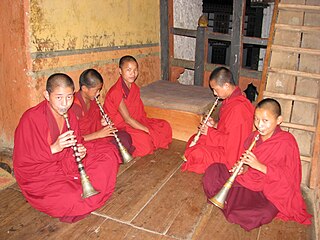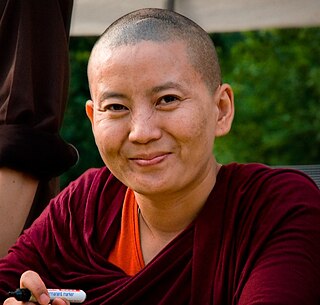Related Research Articles

Tibet is a region in East Asia covering much of the Tibetan Plateau spanning about 2,500,000 km2 (970,000 sq mi). It is the traditional homeland of the Tibetan people as well as some other ethnic groups such as Monpa, Tamang, Qiang, Sherpa, and Lhoba peoples and is now also inhabited by considerable numbers of Han Chinese and Hui people. Tibet is the highest region on Earth, with an average elevation of 4,380 m (14,000 ft). Located in the Himalayas, the highest elevation in Tibet is Mount Everest, Earth's highest mountain, rising 8,848 m (29,029 ft) above sea level.

The Tibetan people are an East Asian ethnic group native to Tibet. Their current population is estimated to be around 6.7 million. In addition to the majority living in Tibet Autonomous Region of China, significant numbers of Tibetans live in the Baltistan region of Pakistan, Chinese provinces of Gansu, Qinghai, Sichuan and Yunnan, as well as in India, Nepal and Bhutan.

In some schools of Buddhism, bardo or antarābhava is an intermediate, transitional, or liminal state between death and rebirth. The concept arose soon after Gautama Buddha's death, with a number of earlier Buddhist groups accepting the existence of such an intermediate state, while other schools rejected it. The concept of antarābhava, an intervening state between death and rebirth, was brought into Buddhism from the Vedic-Upanishadic philosophical tradition. Later Buddhism expanded the bardo concept to six or more states of consciousness covering every stage of life and death. In Tibetan Buddhism, bardo is the central theme of the Bardo Thodol, the Tibetan Book of the Dead, a text intended to both guide the recently deceased person through the death bardo to gain a better rebirth and also to help their loved ones with the grieving process.

Yungchen Lhamo is a Tibetan singer-songwriter living in the United States. She won an Australian Record Industry Association (ARIA) award for best folk/world/traditional album in 1995 and was then signed by Peter Gabriel's Real World record label.
A chant is the iterative speaking or singing of words or sounds, often primarily on one or two main pitches called reciting tones. Chants may range from a simple melody involving a limited set of notes to highly complex musical structures, often including a great deal of repetition of musical subphrases, such as Great Responsories and Offertories of Gregorian chant. Chant may be considered speech, music, or a heightened or stylized form of speech. In the later Middle Ages some religious chant evolved into song.

The music of Bhutan is an integral part of its culture and plays a leading role in transmitting social values. Traditional Bhutanese music includes a spectrum of subgenres, ranging from folk to religious song and music. Some genres of traditional Bhutanese music intertwine vocals, instrumentation, and theatre and dance, while others are mainly vocal or instrumental. The much older traditional genres are distinguished from modern popular music such as rigsar.
Buddhist culture is exemplified through Buddhist art, Buddhist architecture, Buddhist music and Buddhist cuisine. As Buddhism expanded from the Indian subcontinent it adopted artistic and cultural elements of host countries in other parts of Asia.
Buddhist music is music created for or inspired by Buddhism and part of Buddhist art.

Music of Ladakh reflects a rich musical heritage and cultural legacy of Ladakh. Ladakhi music is similar to the music of Tibet. Ladakh is also called Mini Tibet.
The Shrivatsa is an ancient symbol considered auspicious in Indian religious traditions.

Tibet developed a distinct culture due to its geographic and climatic conditions. While influenced by neighboring cultures from China, India, and Nepal, the Himalayan region's remoteness and inaccessibility have preserved distinct local influences, and stimulated the development of its distinct culture.
The Mañjuśrī-Nāma-Saṃgīti is considered amongst the most advanced teachings given by the Shakyamuni Buddha. It represents the pinnacle of all Shakyamuni Buddha's teachings, being a tantra of the nondual (advaya) class, along with the Kalachakra Tantra.

Geshe Ngawang Tashi Bapu a.k.a. Lama Tashi is former Principal Chant Master of Drepung Loseling Monastery, one of the largest monasteries of the Dalai Lama. In 2006, Lama Tashi was nominated for the Grammy Award for his album "Tibetan Master Chants" in the "Best Traditional World Music". Through this achievement, he has created the record of the first Buddhist Monk for Grammy Nomination in solo performance, and the first North-East Indian to be nominated for the prestigious Grammy Award the highest honour of Music in the world. Lama Tashi led Long Life Puja Chanting for the 14th Dalai Lama, the HE 99th and 100th Gaden Tripa Rinpoches and many more highly revered masters. The Long Life Puja is a very popular traditional healing ceremony that involves a multiphonic chant performance to heal the listeners and increase their life span. Lama Tashi also led the chanting performance of the Traditional Great Prayer Festival at Bodh Gaya presided over by the 14th Dalai Lama in 2002. Lama Tashi served as the Principal and the Director of the Central Institute of Himalayan Culture Studies, Dahung, India from 2003-2012 and 2012-2018 respectively. While at the Institute, he taught Buddhist Philosophy at University level students.

A damaru is a small two-headed drum, used in Hinduism and Tibetan Buddhism. In Hinduism, the damaru is known as the instrument of the deity Shiva, associated with Tantric traditions. It is said to be created by Shiva to produce spiritual sounds by which the whole universe has been created and regulated. In Tibetan Buddhism, the damaru is used as an instrument in meditation practices.

Monlam also known as The Great Prayer Festival, falls on 4th–11th day of the 1st Tibetan month in Tibetan Buddhism.

GyutoTantric University is one of the great monastic institutions of the Gelug Order.

Ani Choying Drolma, also known as Choying Dolma and Ani Choying, is a Nepalese Buddhist nun of Tibetan origin and musician from the Nagi Gompa nunnery in Nepal. She is known in Nepal and throughout the world for bringing many Tibetan Buddhist chants and feast songs to mainstream audiences. She has been recently appointed as the UNICEF Goodwill Ambassador to Nepal.
David Sidney George Lewiston was a London-born collector of the world's traditional music. He is best known for his recordings initially released on LP on the Explorer Series of Nonesuch Records beginning in 1967.
Jonathan Goldman is an American author, musician and spiritual teacher in the fields of Harmonics and Sound Healing. He is based in Boulder, Colorado.

The culture of Ladakh refers to the traditional customs, belief systems, political systems that are followed by Ladakhi people in India. The languages, religions, dance, music, architecture, food, and customs of the Ladakh region are similar to neighboring Tibet. Ladakhi is the traditional language of Ladakh. The popular dances in Ladakh include the khatok chenmo, cham, etc. People of Ladakh also celebrate several festivals throughout the year, some of the most famous ones being Hemis Tsechu and Losar.
References
- ↑ "Ritual Dance and Chant". Conservancy for Tibetan Art & Culture. Archived from the original on 2007-12-03. Retrieved 2008-01-16.